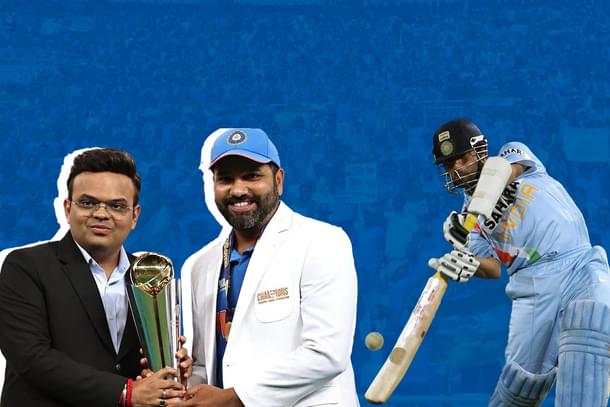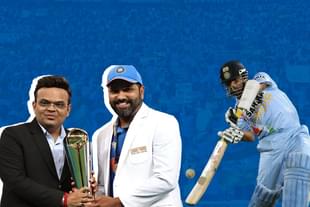Sports
The Only Way To Save ODI Cricket — Multilateral Tournaments
Abhishek Kumar
Mar 19, 2025, 01:39 PM | Updated 06:01 PM IST
Save & read from anywhere!
Bookmark stories for easy access on any device or the Swarajya app.


The 2025 edition of the Champions Trophy, the second-most cherished one-day cricket (ODI) tournament, ended with India as the winner.
However, the tournament will not be counted as a successful one. Most of the matches failed to gather crowds — both in stadiums and on screens.
The low viewership in the tournament aligns with the general trend in recent years of people preferring not to watch ODIs. The format offers the best of both worlds; it has phases where players can play with soft hands, like in Test cricket, while also offering the opportunity to free one's hands, as batsmen often do in Twenty20 (T20), in other phases. Still, ODIs are barely surviving.
The format's declining relevance was reflected in a cricketer's remarks during the three-match ODI series between India and England, held just before the Champions Trophy. When asked about his team’s loss to India, England opener Ben Duckett said, "If we lose 3-0 to India, I don't care as long as we beat them in the final of the Champions Trophy."
Other teams, too, are not taking ODI bilaterals seriously. That is one of the reasons why the Pakistan Cricket Board (PCB) opted for a short tri-series between Pakistan, New Zealand, and South Africa in February 2025 in the run-up to the Champions Trophy.
What's the future of ODI cricket, then?
The format that once brought in big money to the sport is now not loved by many, especially the young audiences.
ODI cricket has faced such a challenge before, even as early as its inception. According to renowned cricket author Martin Williamson, in the first eight years of the format, only 60 ODIs were played by countries worldwide. Twenty-five per cent of these matches were played in the 1975 World Cup alone.
Kerry Packer, a renowned Australian businessman, saw an opportunity to use ODI cricket as a cash draw and introduced the World Series Cricket, featuring more than two teams.
Despite the divergent views between the Australian Cricket Board (ACB, now Cricket Australia) and Packer, all of Packer’s demands were ultimately accepted, except for fielding four teams in a 40-match tournament. Both sides agreed to field three teams for 20-match tournaments every year, with Australia as the host nation.
The tournament’s scheduling was more in line with the Australian cricketing calendar — the host nation, not surprisingly, failed to reach the finals only twice — in the 1996/97 and 2001/02 editions of the tournament. Australia won 20 titles, as very few teams could challenge them.
The tri-series format offered a variety of entertainment avenues for spectators, broadcasters, and cricket boards.
Spectators and sports enthusiasts were thrilled by the opportunity to watch players from the other teams go up against their own team and make assessments about their relative strengths and weaknesses.
The tri-series especially offered an excellent testing ground to assess teams’ preparedness for multilateral events. There was also the challenge of playing in different conditions. The venues in Australia varied from the bouncy tracks of Perth to the spinning wickets of Sydney. The large grounds also tested cricketers’ fitness levels.
The ACB and Packer also marketed the tournament differently — coloured clothing, day-night games, and the white ball offering slightly different reactions to air turbulence. Over time, laser shows and pyrotechnics were introduced.
Australian cricketers also added their own spice by ramping up sledging in the slip cordon. The sight of the big blokes Andrew Symonds and Matthew Hayden getting in the ears of Indian openers still haunts those viewers who tuned into the proceedings at 5 am.
The nearly three-decade journey of the tournament, which later featured nine teams, fulfilled the expectations of cricket lovers despite Australia’s dominance. If Australia were a sureshot finalist, viewers would run their calculations to see who among the other contenders could go up against them in the final. Australia's opponents therefore had all to play for, and viewers were excited right until the end.
Bilateral ODI tournaments, on the other hand, were a more straightforward affair, where early momentum gained by one team could be hard to arrest over the course of the series.
“A tri-series is always better. For instance, if India is playing a three- or five-match ODI series against Australia and wins the first three games, the remaining matches become dead rubbers. In my opinion, there’s no real excitement in watching those games," Ankit Kunwar, Lead Editor at Sportsdunia, says. "However, in a tri-series, the final match or the best-of-three-finals format determines who will lift the trophy, keeping the excitement and competitiveness alive until the end.”
The Australian tri-series and the moments they generated offered a greater recall value than bilaterals.
Once, for instance, when West Indies needed three runs to win off a single ball, all 10 fielders of the English team were positioned at the boundary line by captain Mike Brearley. No one saw it coming. The move forced the International Cricket Council (ICC) to amend its rules regarding fielding.
The tournament also produced gems like the fastest 50 by Lance Cairns, the first tied ODI game, the most economical bowling figures in ODI history, and there was also the case of the then-West Indian captain suing The Age for libel and winning $100,000.
By the 1990s, other cricket boards had begun to realise the profitability of this tri-series tournament, and started to show a keen interest in hosting it. But every good thing comes to an end, and so did the Australian tri-series.
Later, the advent of T20 cricket provided more avenues for entertainment over a shorter span and became the preferred option for audiences.
For Australian cricketers, the CB series followed the Tests at home. Now the board had to make room for T20s as well. Additionally, in a world on the cusp of receiving a cricket bonanza in the form of the Indian Premier League (IPL), losing broadcast money by hosting neutral matches did not sound attractive.
It was only a matter of time before a pragmatic call would be made to pull down the curtains on arguably the most famous tournament after the global ICC event, the ODI Cricket World Cup. The 2007/08 version of the tri-series was the last one. Sachin Tendulkar’s century in one of the finals was his first ODI century on Australian soil in a career spanning 18 years.
Cricket Australia did try to revive the tournament later, but the level of excitement kept low, and so they had to shelve their plans.
Sports journalist Vivek Kishnan pointed out that between 2000 and 2010, India played 121 matches in tri-series or quadrangular tournaments, but since 2011, this number dropped to just 20. Globally, multilateral ODIs have also seen a sharp fall from 439 matches (2000-2010) to just 96 since 2011.
There was a time when it was assumed that ODIs and T20s would survive as the longer and shorter formats of the game, respectively, just as Tests and ODIs did for a long time. However, the love for Test cricket among viewers was surprisingly great, which resulted in Test matches occupying handsome broadcast space (even though stadium attendance remained low).
It was suggested that the money made from T20 cricket could be used to keep Test cricket alive. At one point, the idea of floating two teams of the same country in different formats was also discussed. But Test matches have adapted to their younger, shorter brethren, and now offer a more balanced mix of aggression and defence compared to the yesteryears.
As this unfolded, ODIs were ignored, and bilateral ODI series became the worst sufferers. Now we are at a stage where the format finds few takers, and cricket boards are seeking innovative ideas to revive it. Boards are trying to keep ODIs alive, but the tight scheduling is offering little help.
Ironically, the antidote to a tight schedule could be trilateral ODI series. In July 2022, Indian captain Rohit Sharma also suggested it as a solution. "I do think it is important, but it can be managed in a better way for sure. The scheduling has to be done with some space as well. You have to play bilateral series. There was a time when we were kids; I grew up watching a lot of tri-series or quadrangular series, but that has completely stopped. I think that can be a way forward so that there is enough time for a team to recover and get back,” he said.
In bilateral ODIs, there is normally a two-day gap between games. However, in a tri-series, this gap varies between two and five days. An itinerary drawn up by this writer illustrates this fact.
On whether tri-series can help revive ODIs, senior journalist Chandra Shekhar Luthra agrees with the cricketing logic, but his experience covering the politics of the sport does not give him cause for optimism.
He says players are not getting proper rest due to the mushrooming of leagues, and boards are looking for various ways to keep schedules more balanced. Reducing ODIs to make space for T20s or organising only T20 and Test series has been proposed. Retrying the old tri-series format is not a bad idea and can be tried, Luthra says.
However, in his view, a big hurdle is the unwillingness of boards to subsidise it with T20 money.
A triangular ODI series mainly benefits the host nation, which earns from broadcasting rights, sponsorships, ticket sales, and in-stadium advertisements (ads). Broadcasting deals contribute the largest share, as networks pay hefty sums running into thousands of crores, expecting to recover costs through ads.
Governments often support these events for tourism benefits. However, the host also bears financial risks — low viewership or poor attendance can lead to sponsorship losses and reduced ticket revenues. This problem is more prevalent in matches that do not feature host nations, especially in a country like India.
One possible way out of this problem would be developing stadiums in smaller cities and hosting neutral matches there. In the long run, it would help in covering gate money since small cities witness larger audiences for neutral matches.
Visiting teams earn significantly less, as they do not receive much broadcasting revenue. Their incomes come from a pre-agreed revenue share and team sponsorships, which gain visibility through TV exposure. ICC funding applies only to sanctioned events, while standalone tri-series rely on host agreements.
Players can increase endorsement value with strong performances, but poor results can hamper sponsorship appeal. Travel and accommodation are usually covered by the host, but additional costs for support staff may arise. Smaller cricket boards often struggle to profit unless financial guarantees exist, making tri-series more financially viable for only the established cricketing nations.
In a way, this problem has a solution of its own. In a world where tri-series would be the norm rather than bilaterals, teams with similar competency levels would play such tournaments. Test-playing nations competing in the longest format and associate nations playing among each other in tri-series, with venues rotating over the years, is a more financially and pragmatically sound solution.
It all boils down to willingness. If the format has to be saved from becoming football-esque, where only the World Cup remains relevant, the England Cricket Board (ECB), the Board of Control for Cricket in India (BCCI), and Cricket Australia (CA) — the "Big Three" of international cricket — need to take the initiative. Luthra, however, does not think that will happen anytime soon.
Abhishek is Staff Writer at Swarajya.





